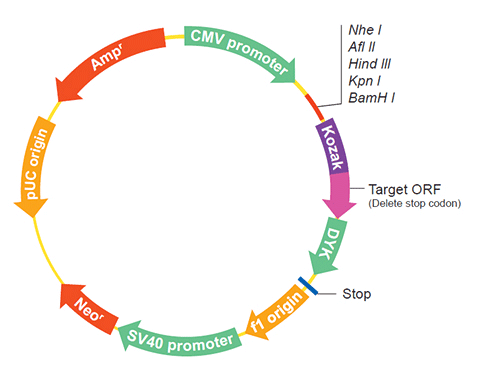| Gene Symbol | HKR1 |
| Entrez Gene ID | 852030 |
| Full Name | Hkr1p |
| Gene Type | protein-coding |
| Organism | Saccharomyces cerevisiae S288C |
HOME
ORF » Species Summary » Saccharomyces cerevisiae S288C » HKR1 cDNA ORF clone
| Gene Symbol | HKR1 |
| Entrez Gene ID | 852030 |
| Full Name | Hkr1p |
| Gene Type | protein-coding |
| Organism | Saccharomyces cerevisiae S288C |
| mRNA | Protein | Name |
|---|---|---|
| NM_001180728.1 | NP_010708.1 | Hkr1p |


The nucleotide sequence of Saccharomyces cerevisiae chromosome IV.
Jacq C, Alt-M?rbe J, Andre B, Arnold W, Bahr A, Ballesta JP, Bargues M, Baron L, Becker A, Biteau N, Bl?cker H, Blugeon C, Boskovic J, Brandt P, Br?ckner M, Buitrago MJ, Coster F, Delaveau T, del Rey F, Dujon B, Eide LG, Garcia-Cantalejo JM, Goffeau A, Gomez-Peris A, Zaccaria P
Nature387(6632 Suppl)75-8(1997 May)
Life with 6000 genes.
Goffeau A, Barrell BG, Bussey H, Davis RW, Dujon B, Feldmann H, Galibert F, Hoheisel JD, Jacq C, Johnston M, Louis EJ, Mewes HW, Murakami Y, Philippsen P, Tettelin H, Oliver SG
Science (New York, N.Y.)274(5287)546, 563-7(1996 Oct)
GeneRIFs: Gene References Into Functions What's a GeneRIF?
interaction between Ste20 and Sho1 contributed to the activation of Hog1 by Hkr1, but not by Msb2.
Title: Yeast osmosensors Hkr1 and Msb2 activate the Hog1 MAPK cascade by different mechanisms.
The osmosensor Hkr1 is required for activation of the yeast cell wall integrity MAPK pathway signaling but Msb2 is not.
Title: Activation of the yeast cell wall integrity MAPK pathway by zymolyase depends on protease and glucanase activities and requires the mucin-like protein Hkr1 but not Msb2.
Data showed that Msb2p had a function in cell polarization through the adaptor protein Sho1p that Hkr1p did not.
Title: The signaling mucins Msb2 and Hkr1 differentially regulate the filamentation mitogen-activated protein kinase pathway and contribute to a multimodal response.
Hkr1 and Msb2 individually form a complex with Sho1, and, upon high external osmolarity stress, appear to induce Sho1 to generate an intracellular signal
Title: Transmembrane mucins Hkr1 and Msb2 are putative osmosensors in the SHO1 branch of yeast HOG pathway.
The following HKR1 gene cDNA ORF clone sequences were retrieved from the NCBI Reference Sequence Database (RefSeq). These sequences represent the protein coding region of the HKR1 cDNA ORF which is encoded by the open reading frame (ORF) sequence. ORF sequences can be delivered in our standard vector, pcDNA3.1+/C-(K)DYK or the vector of your choice as an expression/transfection-ready ORF clone. Not the clone you want? Click here to find your clone.
| CloneID | OSi01496 | |
| Clone ID Related Accession (Same CDS sequence) | NM_001180728.1 | |
| Accession Version | NM_001180728.1 Latest version! | Documents for ORF clone product in default vector |
| Sequence Information | ORF Nucleotide Sequence (Length: 5409bp) Protein sequence SNP |
|
| Vector | pcDNA3.1-C-(k)DYK or customized vector |  User Manual User Manual |
| Clone information | Clone Map |  MSDS MSDS |
| Tag on pcDNA3.1+/C-(K)DYK | C terminal DYKDDDDK tags | |
| ORF Insert Method | CloneEZ™ Seamless cloning technology | |
| Insert Structure | linear | |
| Update Date | 2019-10-31 | |
| Organism | Saccharomyces cerevisiae S288C | |
| Product | Hkr1p | |
| Comment | Comment: REVIEWED REFSEQ: This record has been curated by SGD. This record is derived from an annotated genomic sequence (NC_001136). ##Genome-Annotation-Data-START## Annotation Provider :: SGD Annotation Status :: Full Annotation Annotation Version :: R64-2-1 URL :: http://www.yeastgenome.org/ ##Genome-Annotation-Data-END## COMPLETENESS: incomplete on both ends. | |
1 | ATGGTCTCAT TGAAAATAAA AAAAATTTTA CTCCTGGTGT CATTGTTAAA TGCAATCGAG |
The stop codons will be deleted if pcDNA3.1+/C-(K)DYK vector is selected.
| RefSeq | NP_010708.1 |
| CDS | 1..5409 |
| Translation |

Target ORF information:
Target ORF information:
|
 NM_001180728.1 NM_001180728.1 |

1 | ATGGTCTCAT TGAAAATAAA AAAAATTTTA CTCCTGGTGT CATTGTTAAA TGCAATCGAG |
The stop codons will be deleted if pcDNA3.1+/C-(K)DYK vector is selected.
The nucleotide sequence of Saccharomyces cerevisiae chromosome IV. |
Life with 6000 genes. |